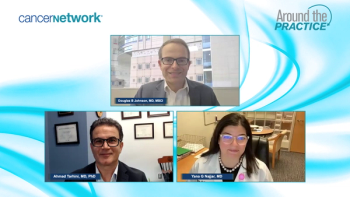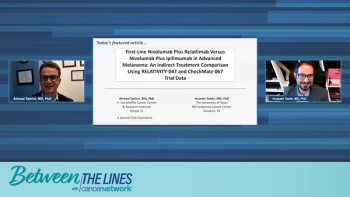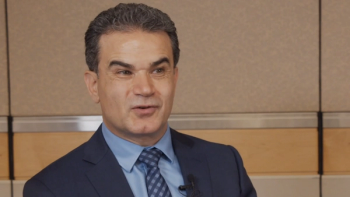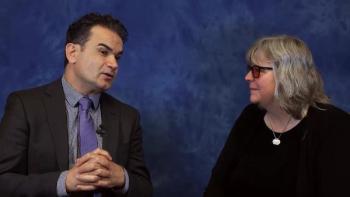Ahmad A. Tarhini, MD, PhD
Articles by Ahmad A. Tarhini, MD, PhD

Panelists discuss how emerging advances in melanoma treatment include next-generation tumor-infiltrating lymphocyte therapy, oncolytic immunotherapy, bispecific antibodies, cancer vaccines, and neoadjuvant approaches that may allow de-escalation of both surgery and systemic therapy while improving treatment-free survival.

Panelists discuss how sequencing immunotherapy combinations strategically can maximize patient outcomes, noting that ipilimumab-nivolumab may work well after progression on relatlimab-nivolumab (an approximately 27%-30% response rate), while the reverse sequence is less effective (an approximately 12% response rate).

Panelists discuss how community oncologists have developed good experience managing immune-related adverse events and are increasingly adopting relatlimab-nivolumab due to its lower toxicity profile and convenient administration schedule of half-hour infusions every four weeks.

Panelists discuss how treatment selection is personalized based on patient characteristics, with relatlimab-nivolumab or monotherapy preferred for frail patients with low disease burden, while ipilimumab-nivolumab might be considered for patients with brain metastases despite its higher toxicity.

Panelists discuss how the dose-response relationship is more pronounced with ipilimumab than with PD-1 inhibitors, explaining why toxicity increases with higher ipilimumab doses while efficacy may not proportionally improve with higher PD-1 inhibitor doses.

Panelists discuss how the toxicity profiles of immunotherapy regimens are fundamentally similar in type but differ significantly in frequency and severity, with ipilimumab-containing regimens causing higher rates of serious adverse events, particularly colitis and hypophysitis.

Panelists discuss how 2 key clinical trials, Checkmate 067 and RELATIVITY-047, established the efficacy of different immunotherapy combinations while highlighting the significant difference in toxicity profiles between ipilimumab plus nivolumab (60% grade 3/4 toxicity) versus relatlimab plus nivolumab (19% grade 3/4 toxicity).

Panelists discuss how monotherapy may still be appropriate for certain patient populations including those with desmoplastic melanoma, solid organ transplants, severe autoimmune disease, and older patients where the toxicity risk of combination therapy may outweigh benefits.

Panelists discuss how the combination immunotherapy approach is superior to monotherapy for most melanoma patients, with specific exceptions such as desmoplastic melanoma where monotherapy shows remarkably high response rates.

Panelists discuss how the treatment paradigm for melanoma has evolved to favor upfront dual checkpoint blockade over targeted therapy, except in specific cases where rapid response is needed for symptomatic patients with high LDH.

Panelists discuss how the ITC analysis of first-line dual-IO treatments in advanced melanoma highlights the potential for nivolumab plus relatlimab to offer similar efficacy to nivolumab plus ipilimumab, with a more favorable safety profile, particularly in terms of lower rates of severe immune-related adverse events.

Panelists discuss how first-line targeted therapy for advanced melanoma, particularly BRAF and MEK inhibitors, may offer significant benefits in patients with BRAF-mutant tumors, emphasizing rapid response and the potential for combination with immunotherapy to improve long-term outcomes.

Panelists discuss how using dual immunotherapy regimens for melanoma in real-world practice involves balancing efficacy with safety, patient comorbidities, and treatment accessibility, while also addressing challenges such as immune-related adverse events and treatment sequencing.

Panelists discuss how treating patients with melanoma and brain metastases requires a multidisciplinary approach, emphasizing the role of immunotherapy, targeted therapy, and local treatments, while considering factors like the extent of metastasis and patient-specific factors.

Panelists discuss how dual immunotherapy for melanoma, including combinations like nivolumab plus ipilimumab or nivolumab plus relatlimab, requires careful consideration of sequencing decisions based on factors such as tumor burden, patient health status, and potential toxicity profiles.

Panelists discuss how the indirect treatment comparison of RELATIVITY-047 and CheckMate 067 suggests that nivolumab plus relatlimab may provide similar efficacy to nivolumab plus ipilimumab in advanced melanoma, with a potentially better safety profile.

Panelists discuss how the RELATIVITY-047 trial data highlights the efficacy of nivolumab plus relatlimab in managing advanced melanoma, offering improved progression-free survival with a favorable safety profile compared to with nivolumab alone.

Panelists discuss how treatment decisions in metastatic melanoma involve balancing the benefits of immunotherapy versus targeted therapy, taking into account factors such as tumor genetics, patient response, and tolerability.

Cancer Network spoke with Ahmad Tarhini, MD, PhD, about the results of the phase III United States Intergroup E1609 trial, presented at ASCO 2019.

Here we summarize the available genomic and genetic tests for melanoma, and the level of evidence supporting each of these. We also discuss the current impact of genomic sequencing on the management of melanoma, as well as roles it may play in the near future.

This peer-to-peer discussion reviews the current strategies for managing patients with melanoma, including screening and prognosis for high-risk patients and how to choose the best therapies to avoid toxicities and treatment resistance.

The unprecedented advances in melanoma immunotherapy are sure to pave the way for immunotherapy development in other tumors.

While the last several decades saw a lack of progress in treatment outcomes in this setting, the outlook has recently changed dramatically, driven by a deepening understanding of melanoma biology and host immunology.

Each year, nearly 60,000 new cases of melanoma are reported in the United States. The vast majority of these are cured by surgery. However, 8,000 of these patients are found to have metastatic melanoma beyond the scope of surgical cure-and this number closely approximates the annual number of deaths from this disease. This statistic illustrates the lack of progress that had been made in the treatment of advanced melanoma over the last several decades.

Annually, about 8,000 patients are found to have metastatic melanoma presenting as recurrence of an earlier primary melanoma, and this number closely approximates the annual number of deaths from the disease. This statistic illustrates the lack of progress that has been made in the treatment of stage IV melanoma over the past several decades.










